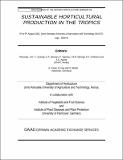| dc.description.abstract | Seeds of spiderplant (Cleome gynandra L.) were sown in soil-filled 20-litre plastic pots. The study was
conducted to investigate the potential for the existence of salinity resistance in C. gynandra. The experimental
design was randomized complete blocks (RCBD) with four replications. Two to four weeks after germination,
the plants were subjected to five levels of salinity, applied by irrigating the pots daily with salt solutions of
concentrations: 0 mol/kg (control), 0.07 mol/kg, 0.13 mol/kg, 0.20mol/kg and 0.26 mol/kg; respectively exerting
osmotic potentials of 0 MPa (control), -0.3MPa, -0.6MPa, -0.9MPa and –1.2MPa in the rooting medium. Data on
growth parameters was collected weekly, including fresh and oven-dried weights of the whole plant as well as
roots, shoots and leaves; water content, chlorophyll content, leaf number, leaf weight ratio, root/shoot ratio
and days to 50% flowering.
Results showed that salinity significantly decreased growth in roots, shoots and leaves and reduce
chlorophyll content. Spiderplant was therefore concluded to possess a poor capacity for regulating the entry,
translocation and compartmentalization of salts, thus allowing large amounts of salt to be absorbed and
translocated to the shoots and leaves, leading to retardation/inhibition of cell division and expansion,
decreased photosynthesis and increased respiration. Observed root death was attributed to the deterioration
of soil structure in the presence of high exchangeable sodium percentage (ESP) in the soil.
Water content and some growth parameters were initially reduced but recovered after some time. This was
attributed to reduction of transpiration and osmotic adjustment. Since plants were able to survive, grow and
reproduce when subjected to up to –0.9 MPa of salt stress in the soil, spiderplant was concluded to have a
moderate degree of salt resistance. Factors contributing to this resistance may include the species’ capacity
for osmotic adjustment and the presence of a C4 (Hatch-Slack) photosynthetic pathway. | en_US |

